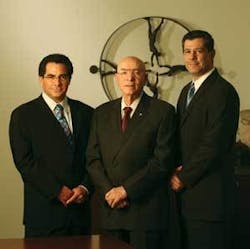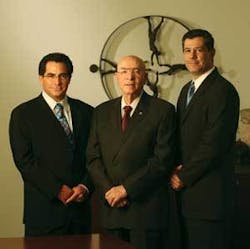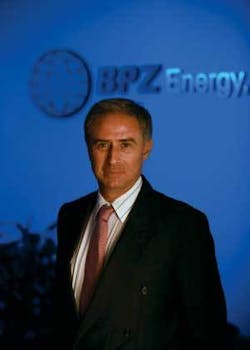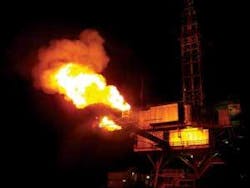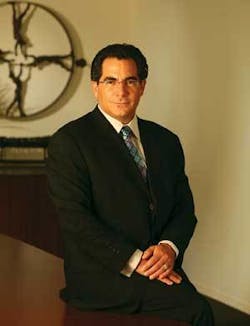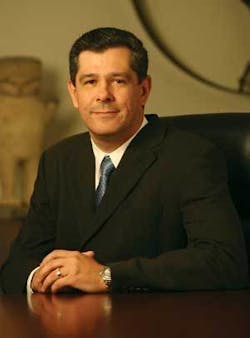Developing Energy Providing Opportunities
Don Stovers, Editor, OGFJ
EDITOR’S NOTE: After meeting Manolo Zúñiga and his father, Dr. Zúñiga y Rivero, at an IPAA small-cap conference in Palm Beach, Fla., in early 2005, I was fascinated by their plan to monetize stranded natural gas assets in Peru by building a gas-to-power project that would be financed in part by an arm of the World Bank. Recently, I was able to get Manolo to sit down and tell me the whole story of BPZ Energy.
AN INTERVIEW WITH BPZ’S MANOLO ZéÑIGADon Stowers, Editor, OGFJ
OIL & GAS FINANCIAL JOURNAL: BPZ Energy’s stated corporate mission is threefold: a) to capitalize on overlooked and under-utilized oil and gas reserves in a way that would benefit local communities, the host country, and shareholders; b) to apply advanced technologies in a cost-effective and environmentally safe manner; and c) to establish a leading presence in South American energy ventures. How have you done so far?
MANOLO ZéÑIGA: We have set the stage to fulfill our mission. We have selectively chosen very promising acreage and have used the latest in technology to ensure success, as evidenced by our initial drilling success in our Corvina field. From the beginning we have engaged the local communities and invested in their future, which we expect to share for years to come, by focusing on child development programs. BPZ’s transparency, technical capabilities, access to capital, and know-how to monetize recently discovered gas will allow us to move to other prospective basins of South America. We will build the company step by step.
OGFJ: Tell us a little about how the company got started. What is your background and what is the background of your father, Dr. Zúñiga y Rivero, who is chairman of the board?
ZéÑIGA: The company was originally set up as an oil and gas consulting firm by three PhD petroleum engineering students at Texas A&M University. Our initials were BPZ, although I told my partners that they were also my mother’s initials, so if they ever left the company I would tell others that the name was based on my mother’s initials. The B and the P left the company soon after, and it took me more than a decade to make the transition from consulting to project development to finally becoming a full-fledged E&P company.
In the process, BPZ developed its strategy and mission. This transition would not have been possible without the help of key supporters, such as our VP of Geology, Tomás Vargas, and, of course, my father.
My father started his career at Exxon’s subsidiary in Peru in 1951 as a micro-paleontologist working in the Talara basin oilfields in northwest Peru and explored many of the areas we now have under contract. When Exxon left Peru in 1969, he stayed with Petroperu (the state petroleum company) as its exploration and production manager and led the company to several successive large oil discoveries in the northern Amazon jungle. He eventually reached the position of CEO and chairman of the board.
After retiring from Petroperu he joined the energy group of the World Bank where during the ‘80s and early ‘90s he played a key role in promoting energy exploration and development throughout the third world. In 1996 he joined BPZ as its chairman and has played a key role in BPZ’s transition into a successful E&P company.
Now that we are conducting challenging operations, I am very happy to have the B back as part of our senior team. Frédéric Briens rejoined the company in late 2004 and is now BPZ’s COO.
In my case, I grew up in the oilfields of Talara where my maternal grandfather was Exxon’s first Peruvian petroleum engineer. As such, I am a third-generation oil man. My grandfather worked with some of Exxon’s technical staff, which later published research that I studied at Texas A&M. I started my career working as a junior engineer for Occidental Petroleum in Bakersfield and later in their oilfields of the northern jungle of Peru. However, my business experience and technical background comes from working in many projects in South America and, as mentioned above, in Peru where we were looking at monetizing recently discovered gas.
OGFJ: How did you go about funding the company initially? Didn’t the initial $120 million financial package come through the International Finance Corp., the private-sector arm of the World Bank? Was this because of the gas-to-power project?
ZéÑIGA: Initially the company was funded by the reverse merger transaction in September 2004 that transformed BPZ into a publicly traded company and several other private placements of BPZ common stock, adding up to $118 million of equity, including the $19.5 million provided by IFC as part of their board-approved $120 million financing package.
The IFC contacted us about financing our initial Corvina gas-to-power project, as they saw it had all the ingredients IFC likes to see, such as the fact that our gas-to-power project would replace diesel and fuel oil in both Peru and Ecuador for power generation. The $120 million financial package is divided into four components: the above-mentioned $19.5 million equity, which closed in December 2006; a $27 million “A” loan, which will be for the IFC’s own account; a $ 70 million “B” loan, which will be syndicated among various international banks; and a $3.5 million “C” loan, which is a mezzanine or quasi-equity instrument.
This $100.5 million debt facility is earmarked for the gas-to-power project and includes the 10-mile pipeline to shore, gas processing facility, and power plant. However, we have also entered into discussions with IFC to increase the size of the debt facility to cover some of the Corvina oil development project as well.
OGFJ: Is IFC still one of the company’s largest investors?
ZéÑIGA: Yes, IFC is our second-largest shareholder and owns about 10% of the company’s stock. So not only will they be a strategic partner on the debt side, but they have a stake in our success as well.
OGFJ: Where has most of the subsequent funding come from – domestic (US) sources or investors in South America and elsewhere?
ZéÑIGA: Our funding to date has been through private placement of our common stock with primarily institutional investors in the US and a few in Europe. Eventually we would like to access the Peruvian financial markets as well.
OGFJ: In June of 2007 you did a private placement in the amount of $37 million. Why did you decide to do this particular transaction?
ZéÑIGA: This transaction was important for us as we needed to ensure the company had sufficient cash to put the Corvina oil discovery into production, which we intend to do before year-end, and to keep drilling in Corvina so we may properly delineate its oil and gas volumes. We will probably keep the rig at Corvina until we complete six oil and/or gas producers, at which time the rig will move to the Albacora field where we expect to replicate our Corvina success.
OGFJ: As a Houston-based energy company, is it harder to get financing for international projects than ones in the United States?
ZéÑIGA: Since we don’t have operations in the US, it’s hard for us to compare. We are finding, however, that there is a lot of interest from institutional investors as well as international banks to finance companies with good international plays such as BPZ, and in particular companies that have our environmental and social record. I believe what sets us apart from other international projects is that we are working in a relatively stable country, Peru, which has maintained the same policies for the past 10 years and is doing extremely well, although much more needs to be done.
OGFJ: What was the genesis of the exploration in the Corvina gas field? Was the idea, what do we do with the recently discovered gas?
ZéÑIGA: The company was founded on an “energy” strategy. We wanted to become a truly integrated energy company involving oil, gas, and power. We knew there was oil in the area; however, we also knew that there was a large amount of recently discovered gas, too. In the past, companies that worked in this area were only looking for oil. They didn’t have a gas strategy nor was there any infrastructure in the area to support a gas project. We, on the other hand, saw the potential of the gas through gas-to-power, regional gas exports, and development of local and regional industry as potential gas off-takers.
In addition, the Peruvian government had recently built a substation with transmission lines capable of handling 360 megawatts of power on a property that is adjacent to our proposed power plant. The transmission lines connect both to the Peruvian grid (180 MW) and the Ecuadorian grid (180 MW). Through the previous drilling and testing in portions of the Corvina and Piedra Redonda fields, we were able to obtain a 3P reserve certification of 4 tcf of natural gas, which will serve as the primary source to develop our initial gas strategy.
OGFJ: How much of your property is offshore, versus onshore?
ZéÑIGA: We have four blocks located in northwest Peru covering approximately 2.4 million acres. Our properties cover three basins, Talara, Tumbes, and Lancones. One of our blocks, Z-1, is located offshore covering 750,000 acres. However, the water depths in the block are mostly 200 feet or less, and only 10% of the block is in what we consider to be “deep” water at depths of 500 to 1,000 feet. In addition, as Block Z-1 is located near the equator, the waters are calm and there are no hurricanes to be concerned about. In other words, while we do operate offshore, the conditions are relatively benign as compared to other offshore locations around the world.
OGFJ: I believe you spudded your first well in the Corvina field in September 2006. How many wells have you drilled to date in this field and what have been the results?
ZéÑIGA: That is correct; we spudded our first well in Corvina in September 2006. To date we have a total of three wells completed and ready for production. We drilled two of the wells, and the third was a re-completion of an existing shut-in gas well. We are currently drilling our fourth well. So far, the results have been excellent. The three wells tested at 5,900 barrels of oil per day and 60 million cubic feet per day of gas; 20 MMcf of gas; and 2,400 bopd and 25 MMcfpd of gas, respectively.
OGFJ: When do you plan to begin construction of the 10-mile pipeline that needs to be built to move the gas from the wells to a gas processing plant on shore, and where do you stand on the power plant construction? When will it go online and began producing electricity?
ZéÑIGA: With the completion of our third well, the 14D, we met the two critical components of the gas-to-power project that IFC was requiring. That is, three wells capable of delivering at least 20 million cubic feet of gas per day and approximately 200 bcf of proved gas in place. With this secured, we are now able to finalize our power purchase agreement and the power plant procurement and construction contract. We expect IFC will complete syndication of the loan by the end of this year or early next year. The power plant along with the 10 mile pipeline and gas process facility will take about 12 months to construct.
to grow the company that is like fitting pieces of a puzzle together.” — Manolo Zúñiga
OGFJ: What other fields does BPZ plan to drill in?
ZéÑIGA: Next, we plan to move on to our Albacora field, which is also located in Block Z-1. We are now in the initial stages of refurbishing the existing drilling platform. The commencement of our drilling operations is somewhat dependent upon the drilling we are currently doing in Corvina, as we will use the same drilling rig. As it stands, we expect to begin our drilling campaign in mid 2008. The Albacora platform has three shut-in oil wells we plan to re-complete and which were producing in total more than 500 barrels of oil per day when they were shut-in. In addition, we plan to drill a twin to a well drilled by Tenneco in 1972, the 8-X-2, which tested at rates of 4,200 bopd and 20 MMcfpd.
Our first onshore well will be in our Block XIX. In late August, we completed a 200 kilometer 2D seismic shoot to help us identify the best location to drill our first wildcat well, which will be an offset to the 5215 well previously drilled by Petroperu in 1973 and which tested for both oil and gas.
We will then move on to Piedra Redonda and Delfin, both in Block Z-1, as well as the main prospects in Blocks XXII and XXIII once we sign the respective license contracts later this year.
OGFJ: Will BPZ be the operator in all these fields?
ZéÑIGA: Yes. We are the operator and have 100% ownership of the license contracts for Blocks Z-1 and XIX, as well as the soon to be signed Blocks XXII and XXIII.
OGFJ: Where did you get the drilling rigs, barges and other equipment needed for drilling and subsequent production? Was it difficult obtaining what you needed?
ZéÑIGA: The drilling rig we have on the CX11 platform is leased from Petrex. A big part of the reason for the delay in drilling our first well, the CX11-21XD, was because the rig we had under consideration was retained by Petrotech after the company had successfully drilled a wildcat oil well south of our operations. This tied up the rig we were in negotiations to lease.
The BPZ-01 barge that is currently moored alongside the CX11 platform was purchased in 2006 from KRS Marine based in Seattle, Wash. The two oil production barges are on a lease with option to purchase from Sur Pacifico. That lease is for a term of two years, but we have the option to purchase the barges at the end of the first year and again at the end of the lease. One barge will be used as an FPSO and the other a transport barge. Both barges have a capacity of 40,000 barrels.
OGFJ: What do you consider your major accomplishments to date?
ZéÑIGA: The most important one has been finding oil in Corvina, which was supposed to be a gas field. It seems now that we may end up with as much oil as gas in place. I do recall, however, a conversation with our well-site geologist while we were drilling our first well, the 21XD, in what turned out to be the oil zone. He indicated to me that the oil shows were so prevalent in the cuttings that he would bet we would test oil from that zone. I told him we actually needed gas for our power project, but he replied that the zone we were drilling would test oil but not to worry as the top zone had plenty of gas. Fortunately he was right in both instances.
When we recompleted the Corvina 16X shut-in gas well, we tested water in the oil zones that had tested oil in the first well, but we still tested 20 MMcfpd of gas. Some thought that to be unfortunate, but that is a nice gas well and still fits into our model [requiring gas for the power project].
We are currently testing the third well, the CX11-14D. I didn’t bother complaining about finding oil in the first drill stem test. In reality, the oil find increased our total pool to over 1,000 acres, which is a nice oil field. We are confident the gas tests on this well will not only produce in excess of 25 MMcfpd but will also get the company over 200 bcf of gas in place required by IFC.
OGFJ: Any setbacks to date?
ZéÑIGA: Every company has setbacks. I prefer to look at them as challenges that we must overcome in order to succeed. First, we had to settle our registration issues with the SEC. That was finalized in November of 2006 under the direction of Ed Caminos, our current CFO. Secondly, the acquisition of our drilling rig took much longer that we would have liked. Third, our first well the 21XD took longer and cost more than we originally planned.
Since last year we have resolved all SEC registration issues, secured the drilling rig under a long-term contract at favorable rates, and despite the extra time and costs of the first well, we have had tremendous oil and gas results from the three wells we have drilled or worked over to date. We also have set forth a step-by-step plan to grow the company that is like fitting pieces of a puzzle together.
I believe that our management team demonstrated its abilities in overcoming these challenges and is capable of handling future roadblocks and keep them from affecting our operating plan for the next several years. That is our commitment, to learn from our challenges and to overcome them.
OGFJ: In January, the American Stock Exchange began listing BPZ. I’m sure this provided greater exposure for the company and a more liquid market for trading.
ZéÑIGA: This was a great move for BPZ. We have watched our volumes grow every month. It is getting easier for major institutions and funds to take large positions in BPZ because of that added volume and increased liquidity. In June we became part of the Russell 2000 Index of small cap companies. This index increased our volume but has also been a double-edged sword. Recently, while volumes increased, we found BPZ’s stock following the Russell 2000’s negative performance at a time when the company was announcing good news. We are very happy to be bucking the trend of late though, as our stock has performed well in recent weeks on the announcement of the successful tests results from the CX11-14D well.
OGFJ: BPZ makes financial presentations at various events, including the Howard Weil Energy Conference, EnerCom’s Oil & Gas Conference, the various IPAA OGIS events, and is scheduled to present at OGFJ’s Houston Energy Financial Forum in November. Can you explain what benefit the company derives from participating in these events?
ZéÑIGA: We find these events to be a great way to get our story out to the market. We find value in the one-on-one meetings at each event, as well as the breakout rooms after the presentations where we can elaborate on items mentioned in the presentations. It was through these types of events that we were introduced to several of our larger shareholders. We know there are many good companies out there and are greatly appreciative of being invited to attend and present at these various events.
The Houston Energy Financial Forum hosted by your magazine is one we decided to sponsor early on in the process. Having this event in Houston is good for everyone because it seems to be an obvious void in the market that you have filled. We look forward to the growth of the conference in Houston in the next several years and hope to be part of making it a success.
OGFJ: Can you tell us a little about your management team – how you assembled it and what experience they have?
ZéÑIGA: Let me start with Frédéric Briens our COO. He is the “B” in BPZ Energy. Frédéric was part of the consulting practice before we went public and was instrumental in our growth early on. I remember going to Frédéric to ask for his help looking over the assets in Peru long after he had left our consulting practice to go work for some of the majors. He graciously took a look at what we had in the region, and shortly thereafter left his position and rejoined BPZ Energy. Frédéric runs our operations in Peru, and without his knowledge and experience, we would not be as successful as we are today.
Ed Caminos was the first person we hired after going public as BPZ Energy. Ed was hired on as our corporate controller to assist our CFO at the time. He is a CPA, has a broad range of financial experience in the international energy industry, including foreign assignments in Venezuela and The Netherlands. As I mentioned earlier, Ed was instrumental in settling our registrations issues with the SEC and taking BPZ to the AMEX. Ed took the reigns as CFO in June of this year and has built a finance team in Houston and Lima that is experienced in all aspects of our business – oil, gas, and power generation.
In addition we have four other key managers who have international oil and gas experience. Tomás Vargas, vice president of geology; Xavier Suniga, vice president of business development; Ed Gilliard, vice president of finance and treasurer; and Rafael Zoeger-Nunez, vice president and general manager in Peru. All have key roles in our company’s development.
OGFJ: As of today, what are your goals going forward – short-term and long-term?
ZéÑIGA: Short-term we are planning to monetize the oil assets we have in the Corvina field in Block Z-1. First revenues from oil production are slated for December of this year. Secondly, we are working to close the funding from IFC which will jumpstart the gas-to-power project. Also, by year’s end, we will have an independently certified reserves report issued on the first three wells, giving us a defined asset base in place. By year’s end we also expect to have the contracts signed on Blocks XXII and XXIII, and continue working on the refurbishment of the Albacora platform.
If short-term is by year-end, then my long-term goals for 2008 and 2009 would be defined as follows:
- Drilling the first well and work over the three shut-in oil wells at Albacora, with production by the end of 2008.
- First electricity sales into Peru by early 2009 from our Corvina gas-to-power project.
- First well drilled in onshore Block XIX in 2008.
- Prove up enough gas in place to begin phase II of our gas strategy which involves gas exports to Arenillas, Ecuador in 2009.
- Begin refurbishment of the platform in Piedra Redonda for drilling in 2009.
- Define the Mancora gas play, which crosses three of our blocks, so as to secure sufficient gas for industry and exports.
- Expand our power plant from 160 MW to 320 MW and grow that revenue stream.
OGFJ: Is there anything else you’d like to add?
ZéÑIGA: Probably one of the things I like to point out the most is we are going step by step in building BPZ. It is like fitting the pieces of the puzzle together. We have over 50 mapped prospects, which should keep us busy for several years.
Our company is not out purely wildcatting for oil and gas, as we are working in fields that have either tested for oil, gas, or both or have had shows of hydrocarbons. Most of these fields were considered “dry” when the operators found gas instead of oil, and our mission is to make a market for the gas by our gas-to-power strategy. The knowledge base of not only my father, our chairman, myself, and our teams in Houston and Peru is invaluable. We know the Peruvian market like Southwestern Energy knows the Fayetteville shale. It is where we have our foundation and why BPZ will continue to be successful.
OGFJ: Thank you for your time.
